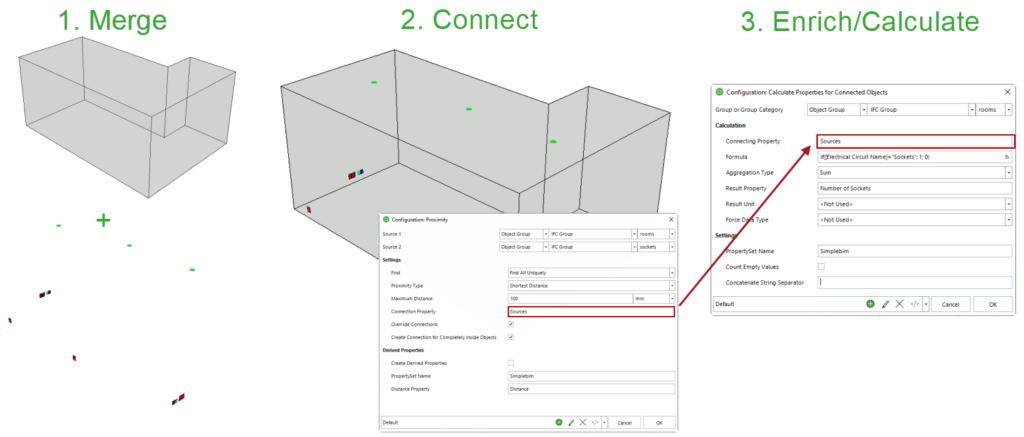15. Create and Use Connections
This page may include version-specific information that is no longer current.
The warning is added automatically and may appear on pages containing version-neutral or up-to-date information.
One of the most powerful ways to enrich BIM data is to create and use connections between building elements.
There are many kinds of connections or relations in BIM models, and there are many ways to use them. Let’s have a closer look and see how Simplebim supports these ideas.

Different Kinds of Connections
Some connections are already created in the model author tools. The walls might have a connection to the adjacent walls, or ducts from a ventilation system might be connected. These connections are between building elements of the same model.
Even more powerful connections can be created between building elements from multiple models from different disciplines.
Connections can be obvious, for example when the building elements collide or seem to touch each other. They can also be more abstract, for example when there’s a connection between building elements inside a room and the room itself, or a section or building storey of a building and the building elements that belong to it.
BIM models also have many kinds of groups, which also create an abstract connection between the group and the building elements assigned to it. In a way also an implicit connection between the building elements themselves, they all belong to the same group.
All these kinds of connections can be used in different ways, to analyze – and maybe even more importantly – to enrich the model data.
Different Ways of Using the Connections
Clash Detection
The most well-known and used way to use connections is to find building elements that collide or are too close to each other. This technique is used for design coordination and building permit checking. The end result is usually simply either yes or no.
Messaging
But a much more powerful and advanced way of using the connections is for “messaging”: letting the building elements ‘talk’ to each other. This is most useful when the building elements come from the different BIM models, in other words, when they don’t know anything about each other by default.
Messaging can be simple or complex. A simple message is for example to copy some property values from one connected building element to another. For example, the room can tell its name to the ventilation ducts in the room.
More complex messages aggregate data through multiple connections and summarize them together. This could be for example summarizing the number or area of the windows in a room through the connection between the room and the windows surrounding it. Or the number of electrical sockets in the room.
Aggregations can be summaries, averages, finding min or max values, or even concatenating text values.
One more possibility when constructing the message is to use formulas to calculate the content.
Creating and Using Connections in Simplebim
What does all this have to do with Simplebim?
First of all, in SImplebim you can use any existing connections found in the BIM models, to enrich and analyze the BIM data and building elements in various ways.
Second, in Simplebim you can create connections by using for example the Proximity, Calculate Quantities for Space Surfaces or Overlapping Objects tool.
Third, once the connections between the building elements have been established, they can be used for enriching the model data, by using for example the Calculate Properties for Connected Objects tool.
See more information in the tool documentation and our online tutorials.
Connections and Graphs
Some of you might think that this sounds a lot like using graphs. If you don’t know what the graphs are don’t worry. We are not talking about the column, bar or pie charts here, which you can create in Excel. The graph in this context are nodes (building elements) connected with edges (the connections).
Once you have graphs you will have access to many very powerful algorithms for grouping, analyzing, and aggregating data. If you are familiar with the possibilities of the graphs, you can think of the connections between the building elements creating them into the BIM models.
There will be much more talk and support for graphs in Simplebim in the future.
Example Use Cases
The possibility to create the connections and to use them for messaging opens up a whole new range of practical applications for BIM data wrangling. Here are some use cases we have come across so far:
- Find the number and type of electrical sockets for each room.
- Find doors for walls for internal walls for fire rating checks or enrichment.
- Find windows for precast elements.
- Find spaces, that are served by an HVAC system.
- Match colours of sprinklers and ceilings.
- Calculate the area of windows and doors for rooms.
- Check that the hot and cold water pipes are not too close to each other.
- Find and derive new objects for HVAC objects, which penetrate internal walls.
This is just the beginning.
We can’t wait to see all interesting use cases you will come up with, using this new, cutting-edge possibility offered by Simplebim!